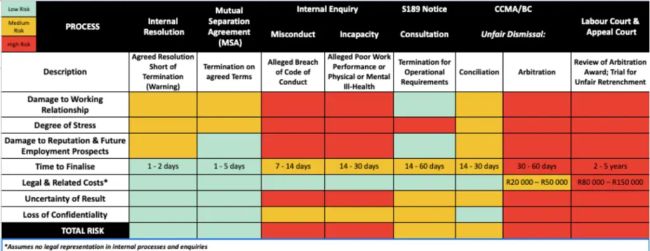Labour Law in a Nutshell Feb-March 2024
Problems & Procedures
Problems inevitably crop up from time to time in any workplace. The problems can become disputes which vary from serious acts of misconduct through to performance failures, physical or mental ill health and business operational issues.
And there're well established rules and procedures to guide us on how to resolve disputes internally. These are the internal processes such as the grievance and disciplinary procedures and the incapacity and retrenchment procedures.
Fear & Risks
It's also inevitable that these situations are stressful and risky for all concerned. The main trigger for the stress and risks is fear:
- fear of uncertainty of the outcome.
- fear of damage to working relationships.
- fear of financial losses.
- fear of threats to future employment prospects.
Legal processes are inherently risky no matter how strong you believe your case to be. And the time and costs involved are beyond the endurance limits and wallet of most employees and small to medium sized businesses.
Employees usually face higher risks than employers who occupy an inherently stronger position in the employment relationship. They have the power to dismiss and to defend their decisions with much more financial clout and access to legal assistance than employees can muster. This enables them to play the "long game" of legal delays while dismissed employees suffer unemployment for long periods of time without jobs and pay.
Limited Legal Solutions
An arbitrator or a judge has a limited range of legal options available when deciding on outcomes and solutions. Unfortunately, they can't cater adequately to repair relationships and reputations which get damaged in the cut of thrust of internal or external legal battles.
It would be useful to assess the risks of internal and external legal procedures before deciding whether to prosecute or defend a potential or actual dismissal. An alternative option to a legal wrangle such as a negotiated settlement may be a smarter strategy.
Risk Matrix
This risk matrix indicates the degree of risk which you should expect to face in each process as measured by a list of risk criteria. It's intended as a general indicator rather than as a precise measurement tool.

TIP: Not surprisingly, it's notable that the matrix shows the highest red zones of risk lie in the semi-legal (internal enquiries) and litigation (CCMA & Court) spaces. These are the zones in which the parties have the least control over outcomes for the most stress, time, and costs: the decisions lie in the hand of enquiry chairpersons, arbitrators, and judges.
In contrast, the least risky zones shown in orange and green lie in processes where the parties have the most control over the outcomes for the least pain: the decisions are negotiated and agreed by the parties in conciliation (mediation) and negotiation (MSA).
The content of this article is intended to provide a general guide to the subject matter. Specialist advice should be sought about your specific circumstances.
